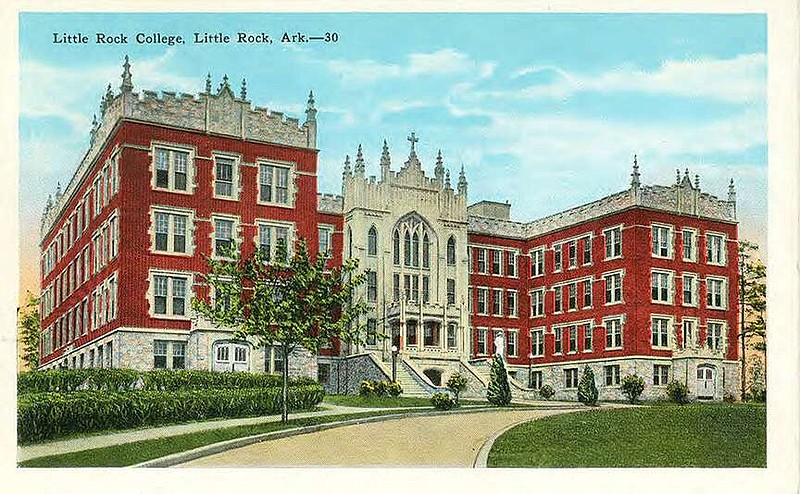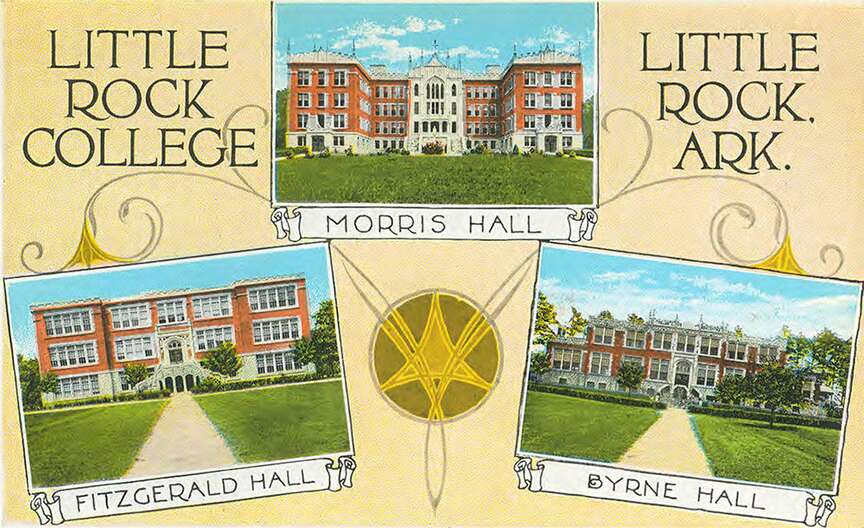Little Rock College was the second attempt by the Diocese of Little Rock to establish an institution of higher education. Andrew Byrne, Arkansas' first Roman Catholic prelate, began St. Andrew's College near Fort Smith in 1849, but it closed in 1861 due to the Civil War. John B. Morris, Arkansas' third Catholic bishop, established Little Rock College using the wealth accumulated by his predecessor, Edward M. Fitzgerald, who died in 1907. Fitzgerald left so much to his successor that, in addition to the college, Morris eventually founded St. Joseph's Orphanage in North Little Rock, a diocesan newspaper and a seminary.
Little Rock College opened in September 1908, situated between 25th and 26th streets, and Gaines and State streets. The Rev. Dennis W. O'Hern served as its first president, and the Rev. Winand Aretz served as vice president. These two clerics, together with five laypeople, made up the faculty for the first academic year. The college originally served only male students, 12 of whom were enrolled the first semester. The catalog listed courses in the liberal arts, along with mechanics, chemistry, electricity, mineralogy, geology and astronomy. The next year, 1909–1910, the students were housed at the old St. Mary's Academy across Louisiana Street from the Cathedral of St. Andrew. St. Mary's Academy and the Mercy sisters had by then moved to Pulaski Heights. By the end of the second year, there were 47 students enrolled at Little Rock College. After two years, O'Hern was replaced by an energetic young priest from New York, the Rev. Herbert Heagney, who remained president from 1910 to 1923.
In 1911, the college was joined by a new seminary, St. John's Seminary, and both institutions operated at the State/Gaines Street location. In 1916, both facilities moved to a new location in Pulaski Heights. At the same time, St. Joseph's Orphanage then moved to the old college and seminary facility. Four years later, St. Joseph's moved back to North Little Rock, while St. John's Seminary returned to the State/Gaines Street location. For the next decade, Little Rock College operated at the Pulaski Heights campus.
In opening this college and seminary, Bishop Morris hoped to raise the educational level of his clergy and laypeople to counteract Arkansas' anti-Catholic prejudice. The strength of this prejudice was illustrated in the fall of 1916. During a football game between Little Rock College and the Russellville Aggies (from what would later become Arkansas Tech University), fans vacated the stadium and began jeering at the Catholic team from the sidelines. The irate crowd then followed the winning Little Rock team to the train station, hurling insults.
One distinguished alumnus of Little Rock College is Arkansas' fourth bishop, Albert L. Fletcher, who graduated from Little Rock College in 1917 with a degree in chemistry. He then entered the seminary and was ordained to the priesthood in 1920. After earning a master of science degree in chemistry from the University of Chicago, Fletcher returned in 1920 to teach at his alma mater.
In 1923, Morris made him president of Little Rock College, a position he held until 1925. Little Rock College opened a pharmacy school in 1924, but it closed after three years. In August 1928, the college announced that it would admit women, but that was not enough to keep it open. The Great Depression brought an end to the college, and Bishop Morris announced on July 12, 1930, that the school would close that fall.
The Pulaski Heights campus was taken over by St. John's Seminary. By 1950, that institution had a capacity of 200 students. In the 1960s, however, the seminary suffered due to high attrition rates. By 1967, with only 50 students enrolled at the school, the overall income was not enough to pay for the operating costs of the school. There was also a shortage of trained faculty members.
Too, in the mid-1960s, the young faculty members at the seminary were far more liberal than most Arkansas Catholics and the bishop at the time. The Rev. James F. Drane, a theologian at St. John's, wrote a series of articles in the Arkansas Gazette questioning the Church's position against artificial contraception. Drane further stated that he hoped to overthrow the "myth" of papal infallibility. Bishop Albert Fletcher suspended him from the priesthood in 1966; Drane then appealed to the Vatican, which backed Fletcher's suspension of the priest.
The seminary was forced to close its doors in the summer of 1967. After its closure, the offices of the Diocese of Little Rock were moved from their downtown location into the campus of the former seminary, which opened in 1968 as the St. John Catholic Center. -- James M. Woods and Lauren White
This story is adapted by Guy Lancaster from the online Encyclopedia of Arkansas, a project of the Central Arkansas Library System. Visit the site at encyclopediaofarkansas.net.

